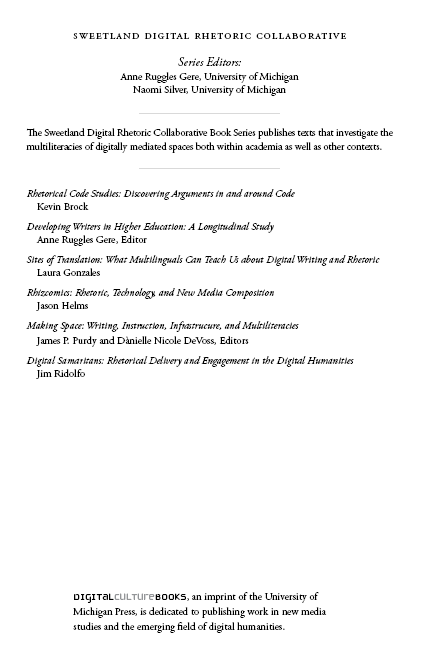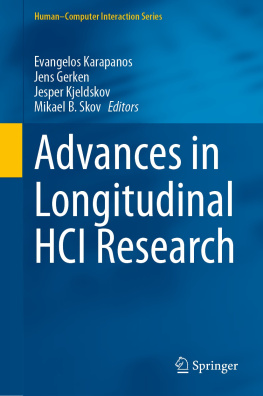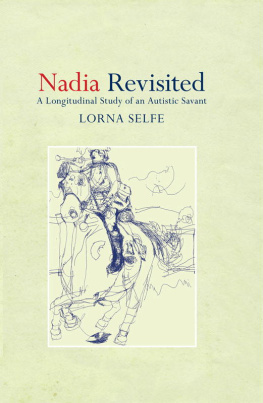Anne Gere - Developing Writers in Higher Education: A Longitudinal Study
Here you can read online Anne Gere - Developing Writers in Higher Education: A Longitudinal Study full text of the book (entire story) in english for free. Download pdf and epub, get meaning, cover and reviews about this ebook. publisher: University of Michigan Press, genre: Home and family. Description of the work, (preface) as well as reviews are available. Best literature library LitArk.com created for fans of good reading and offers a wide selection of genres:
Romance novel
Science fiction
Adventure
Detective
Science
History
Home and family
Prose
Art
Politics
Computer
Non-fiction
Religion
Business
Children
Humor
Choose a favorite category and find really read worthwhile books. Enjoy immersion in the world of imagination, feel the emotions of the characters or learn something new for yourself, make an fascinating discovery.

- Book:Developing Writers in Higher Education: A Longitudinal Study
- Author:
- Publisher:University of Michigan Press
- Genre:
- Rating:3 / 5
- Favourites:Add to favourites
- Your mark:
- 60
- 1
- 2
- 3
- 4
- 5
Developing Writers in Higher Education: A Longitudinal Study: summary, description and annotation
We offer to read an annotation, description, summary or preface (depends on what the author of the book "Developing Writers in Higher Education: A Longitudinal Study" wrote himself). If you haven't found the necessary information about the book — write in the comments, we will try to find it.
Anne Gere: author's other books
Who wrote Developing Writers in Higher Education: A Longitudinal Study? Find out the surname, the name of the author of the book and a list of all author's works by series.
Developing Writers in Higher Education: A Longitudinal Study — read online for free the complete book (whole text) full work
Below is the text of the book, divided by pages. System saving the place of the last page read, allows you to conveniently read the book "Developing Writers in Higher Education: A Longitudinal Study" online for free, without having to search again every time where you left off. Put a bookmark, and you can go to the page where you finished reading at any time.
Font size:
Interval:
Bookmark:

Page ii 
Edited by Anne Ruggles Gere
University of Michigan Press
Ann Arbor
Page iv Copyright 2019 by Anne Ruggles Gere
Some rights reserved

This work is licensed under a Creative Commons Attribution-NonCommercial-NoDerivatives 4.0 International License. Note to users: A Creative Commons license is only valid when it is applied by the person or entity that holds rights to the licensed work. Works may contain components (e.g., photographs, illustrations, or quotations) to which the rightsholder in the work cannot apply the license. It is ultimately your responsibility to independently evaluate the copyright status of any work or component part of a work you use, in light of your intended use. To view a copy of this license, visit http://creativecommons.org/licenses/by-nc-nd/4.0/
Published in the United States of America by the
University of Michigan Press
Manufactured in the United States of America
A CIP catalog record for this book is available from the British Library.
Library of Congress Cataloging-in-Publication data has been applied for.
ISBN 978-0-472-13124-2 (hardcover : alk. paper)
ISBN 978-0-472-03738-4 (pbk. : alk. paper)
ISBN 978-0-472-12481-7 (e-book)
https://doi.org/10.3998/mpub.10079890
This project was made possible in part through the University of Michigans Humanities Collaboratory and its Book Unbound project grant.
Cover art iStock/from 2015
Page v For John W. Sweetland
Anne Ruggles Gere
Emily Wilson and Justine Post
Benjamin Keating
Lizzie Hutton and Gail Gibson
Ryan McCarty
Laura L. Aull
Zak Lancaster
Anna V. Knutson
Naomi Silver
Sarah Swofford
Anne Ruggles Gere
Anne Ruggles Gere
Digital resources for this book are available on our Fulcrum platform at https://www.doi.org/10.3998/mpub.10079890
When I became director of the Gayle Morris Sweetland Center for Writing in 2008, I knew I wanted to undertake a longitudinal study of student writers, but I had no idea that it would take nearly a decade, call upon multiple resources, and involve dozens of collaborators. Grants from the University of Michigans Center for Research on Learning and Teaching and Instructional Support Services supported the earliest stages of this study. Thanks to resources from the Deans Scholarship provided by the School of Education, funds from the College of Literature, Science and the Arts, and, especially, the endowment of the Gayle Morris Sweetland Center for Writing, a succession of graduate student research assistants helped to move this project from concept to reality.
Tim Green and Laura Aull helped to launch the essay-based Directed Self-Placement that provided a common baseline for all students. Anne Porter led an investigation of writerly efficacy; Christie Toth drew on resources from the Institute for Social Research to draft and refine our survey; Sarah Swofford and Lizzie Hutton developed the coding system for interviews; Ben Keating found and used the aptly named Site Sucker app to preserve the contents of students electronic portfolios; Anna Knutson wrangled coded interviews into searchable form; Ryan McCarty dove deep into students electronic portfolios and archived writing to create cases for analysis; Emily Wilson organized and tabulated data for our digital resources; and Naitnaphit Limlamai coordinated our final push into publication.
A number of other graduate students augmented this small platoon of contributors. Michael Brown, Elizabeth Mann, and Alon Yakter made statistical sense of our survey data. Sheerah Cole, Merideth Garcia, Gail Gibson, Jonathon Harris, Michelle Kwok, Chris Parsons, Molly Parsons, Melody Pugh, Emily Rainey, Aubrey Schiavone, Nicole Wilson, and Crystal VanKooten conducted interviews. Ann Burke, Merideth Garcia, Gail Gibson, James Hammond, Jonathon Harris, Stephanie Moody, Amanda Presswood, Lavelle Ridley, Aubrey Schiavone, Bonnie Tucker, Nicole Wilson, and Crystal VanKooten helped code transcripts of interviews. Page xii Jathan Day, Michael Hoffman, Adrienne Raw, and Ruth Li assisted with the development of digital materials.
Throughout the coming and going of graduate students my most constant and valued collaborator was Naomi Silver, Associate Director of Sweetland. Thinking with her about virtually every aspect of this project, benefiting from her scrupulous attention to my prose, and learning from her deep knowledge of multimedia writing made this study both more effective and more fun. Naomis leadership in developing the curriculum for Sweetlands Minor in Writing, her innovative approaches to teaching multimedia writing, and her enormous contributions to Sweetlands Digital Rhetoric Collaborative created the context that made this study possible. As I step away from directing Sweetland, one of the things Ill miss most is working daily with Naomi.
A grant from the University of Michigans Humanities Collaboratory for the Book Unbound project gave digital life to this study. Originally this was to have been solely a print book project, but joining forces with colleagues Charles Watkinson, Director of the University of Michigan Press; Nicola Terrenato, a professor of classical archaeology; and Matthew Solomon, a professor of screen arts and cultures, led to a successful proposal that united our study of writing with one focused on the excavation of Gabii, a city that neighbored and rivaled Rome in the first millennium BC, and another on Orson Welles planned but unmade film version of Heart of Darkness. Sharing ideas across disciplines as each of our projects prepared to mount scholarship and data on the Fulcrum platform emboldened many ideas, which took actual form thanks to the interventions of Kentaro Toyama, a professor in the school of information; Jeremy Morse and his colleagues in the publishing technologies group; Kevin Rennells, production editor; and Mary Francis, editorial director the Michigan publishing. These colleagues, along with very helpful anonymous reviewers and my stalwart writing group colleaguesAnne Curzan, Mary Schleppegrell, and Meg Sweeneyhelped move this project to new levels of complexity and accessibility.
Of course none of this would have been possible without the generous cooperation of the students who participated in this study. Their willingness to complete lengthy surveys, participate in interviews, and regularly share their writing with us provided the materials on which this study is based. They opened windows into their learning and taught us a great deal about what writing development can mean. I cannot thank them all by name here, but their contributions are visible on every page of this book.
The authors of the chapters included in this collection shared my goal of making every contribution closely linked to all the others so that readers could experience Page xiii it in more holistic terms. This meant close readings and discussions of one anothers drafts, not just once, but multiple times. Across two summers and much of an academic year we met regularly, sometimes virtually and sometimes face to face, but always to share perceptions and make suggestions on one anothers writing. I am deeply grateful to Emily, Justine, Ben, Lizzie, Gail, Ryan, Laura, Zak, Anna, Naomi, and Sarah for the many hours they invested in building bridges across chapters.
Next pageFont size:
Interval:
Bookmark:
Similar books «Developing Writers in Higher Education: A Longitudinal Study»
Look at similar books to Developing Writers in Higher Education: A Longitudinal Study. We have selected literature similar in name and meaning in the hope of providing readers with more options to find new, interesting, not yet read works.
Discussion, reviews of the book Developing Writers in Higher Education: A Longitudinal Study and just readers' own opinions. Leave your comments, write what you think about the work, its meaning or the main characters. Specify what exactly you liked and what you didn't like, and why you think so.




